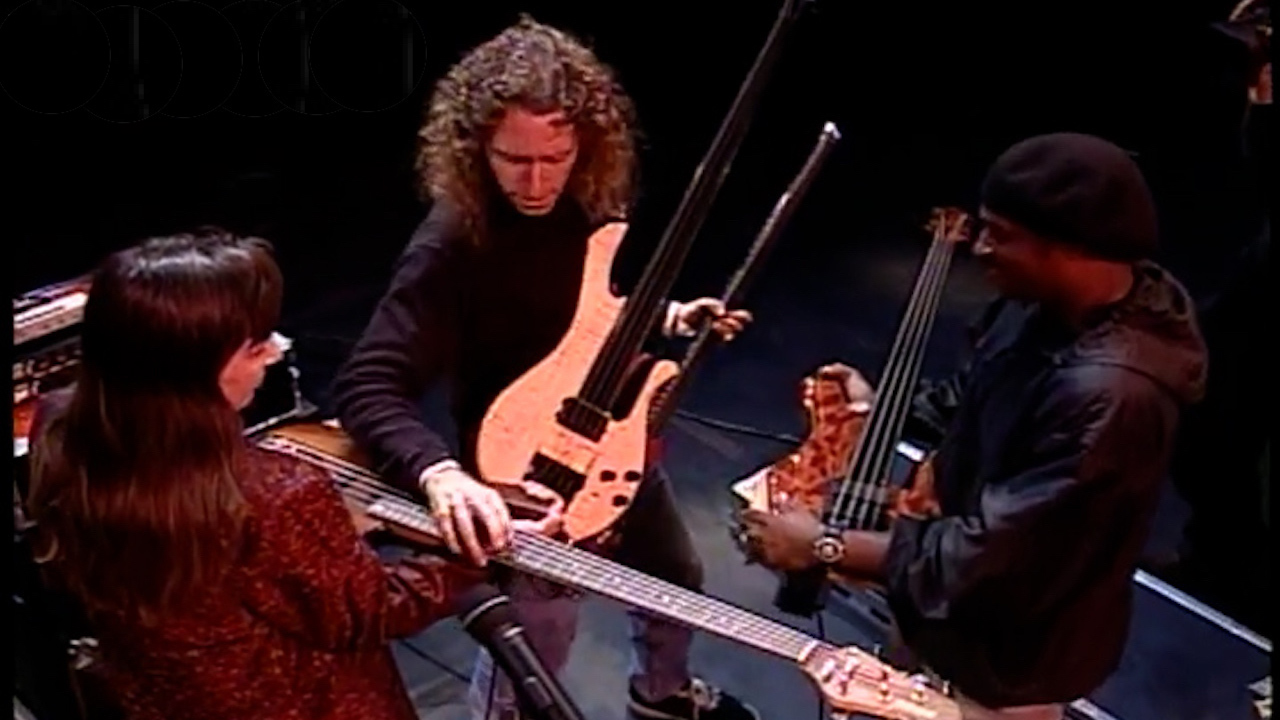Watch the world’s ‘leading solo bassist’ play four different bass guitars at the same time
Michael Manring: “I’d travel with four basses and I started getting asked: ‘Why don’t you play all of them at once?’”

Melding an astounding level of technical skill with an intuitive sense of what’s compositionally possible on the bass guitar, Michael Manring has developed a solo approach that’s completely unique. While the result may have little relevance to conventional bass playing, his advances in solo bass continue to reflect his own impulsive instincts rather than change for change’s sake.
“It was almost entirely a case of I need to do this,” says Manring of his solo career. “I would be playing solo bass whether anyone was listening to me or not! But at the same time there has been a lot of ‘What would happen if I do this?’ and ‘Why is this not done on the bass? And what would happen if I try?’ I guess my mind kind of works that way.”
One of Manring’s most unusual compositions – atleast in terms of performance – is My Three Moons, which is played on four bass guitars simultaneously. “I would often travel with four basses,” explains Michael. “And I started getting asked, ‘Why don’t you play all of them at the same time?’ I realised eventually I was going to have to live up to that challenge!”
Bassists have always found much to marvel at in Manring's work. Not least his ability to combine all manner of harmonics, percussive sounds, and some very un-bass-like tones in his performances. “My goal ever since I was a young guy was to have a pretty fluid technique," he told BP. "Just so I could play whatever I wanted to play. There are still refinements along the way, but depending on what kind of sound or concept I’m looking for, it’s just a matter of trying to refine that, which usually lets me know what direction I need to go.”
Another aspect of Michael's expressive tonality lies in his fretless sound, often enhanced by his use of an EBow to create seemingly endless sustained notes. “In terms of the fretless, I think it’s pretty much all about intonation. I work really hard on being able to play in tune and I always play with a reference point, so whenever I’m playing on the fretless I’ll have a tuner plugged in, or I’ll be playing against a drone or a sequence or a loop. Other than that it’s just about the different kinds of inflections you can use.”
Championed by his former tutor Jaco Pastorius on his solo tune, Portrait Of Tracy, the use of harmonics is another area that Michael has championed in his solo playing. “When I think about harmonics I think about what notes I want to have available to me and how I can tune the bass in order to have the set of notes that I need. There’s a limited number that are available, and basically what you end up having is this kind of dominant seventh chord based on the fundamental of the open string, but there’s so many ways to play them.”
Manring’s relentless search for new sounds led to creation of his signature Zon Hyperbass, an instrument that boasts a three-octave fretless fingerboard and seemingly endless tuning capabilities. “I’m so lucky to have somebody like Joe Zon who is interested in building these crazy instruments that I dream up. Somehow he has learnt how to build an instrument and really give it a voice so that it almost speaks for itself. There’s some kind of added mojo in there; I don’t know what it is and I usually don’t even ask! It probably involves sacrificing chickens or something! I don’t want to know about that!”
Get The Pick Newsletter
All the latest guitar news, interviews, lessons, reviews, deals and more, direct to your inbox!
Michael's 2020 solo album, Small Moments, is available to buy or stream.

Nick Wells was the Editor of Bass Guitar magazine from 2009 to 2011, before making strides into the world of Artist Relations with Sheldon Dingwall and Dingwall Guitars. He's also the producer of bass-centric documentaries, Walking the Changes and Beneath the Bassline, as well as Production Manager and Artist Liaison for ScottsBassLessons. In his free time, you'll find him jumping around his bedroom to Kool & The Gang while hammering the life out of his P-Bass.
“I asked him to get me four bass strings because I only had a $29 guitar from Sears”: Bootsy Collins is one of the all-time bass greats, but he started out on guitar. Here’s the sole reason why he switched
“I got that bass for $50 off this coke dealer. I don’t know what Jaco did to it, but he totally messed up the insides!” How Cro-Mags’ Harley Flanagan went from buying a Jaco Pastorius bass on the street to fronting one of hardcore’s most influential bands










